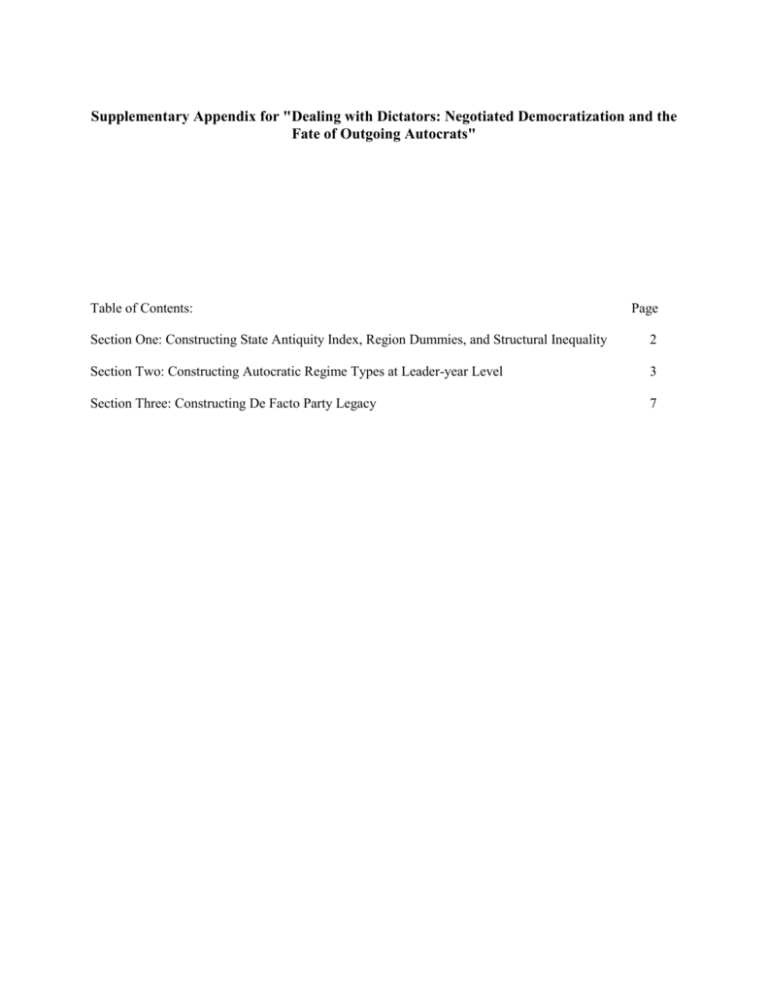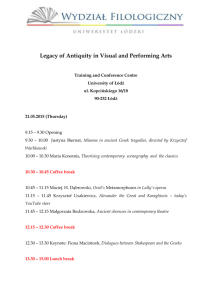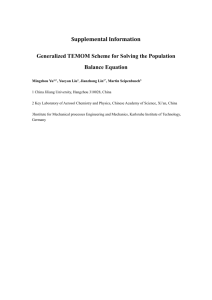Supplementary Appendix.
advertisement

Supplementary Appendix for "Dealing with Dictators: Negotiated Democratization and the Fate of Outgoing Autocrats" Table of Contents: Page Section One: Constructing State Antiquity Index, Region Dummies, and Structural Inequality 2 Section Two: Constructing Autocratic Regime Types at Leader-year Level 3 Section Three: Constructing De Facto Party Legacy 7 SECTION ONE: CONSTRUCTING STATE ANTIQUITY INDEX AND REGION DUMMIES 1. State Antiquity Index We follow Bockstette et al. (2002) and measure state capacity as the State Antiquity Index, a proxy for the longevity of a state’s infrastructure and bureaucratic culture. Bockstette et al. (2002) discount the influence of the past for each half-century at various rates. We employ, as recommended by them, the 5% discount rate. We also use the version of the index normalized to run from 0 to 1, where the sum of the discounted series is divided by the maximum possible value the series could take given the same discount rate. We follow Putterman and Weil (2010) and adjust the State Antiquity index by migration patterns. Specifically, to address the fact that during the colonization of the Americas, Sub-Saharan Africa, and Asia, European settlers and non-European indentured servants and slaves migrated in different numbers, displaced indigenous populations to different degrees, and imported their home institutions with varying measures of success, we weight this ratio by Putterman and Weil’s World Migration Matrix. This matrix allows researchers to adjust crosscountry indicators to reflect the history of a population’s ancestors, rather than the history of the place they live today. Specifically, the matrix discloses the different shares of a country’s population in 2000 that are descended from people in different source countries in the year 1500. For example, Mexico’s Antiquity Index is multiplied by Mexicans’ share of ancestors of Aztec descent and adjusted by Spain’s State Antiquity Index multiplied by Mexicans’ share of ancestors of Spanish descent. This allows us to capture both the state capacity accumulated by the Aztecs during the PreColombian period and the legacy of Spanish state capacity as introduced by the Conquistadores during the 16th Century. See Putterman, Louis, and David Weil. 2010. “Post-1500 Population Flows and the Long-Run Determinants of Economic Growth and Inequality.” The Quarterly Journal of Economics 125: 16271682. 2. Region Dummies In the regressions where we include region fixed effects, we have constructed the region dummies following Hadenius & Teorell (2005), “Assessing Alternative Indices of Democracy, C&M Working Papers 6, IPSA” (available at: http://www.conceptsmethods.org/working_papers/20050812_16_PC%206%20Hadenius%20&%20Teorell.pdf), who divide the world into ten politico-geographic regions. It is based on both geographical proximity and demarcation by area specialists who have contributed to a regional understanding of democratization. The ten regions are: 1) Eastern Europe and post Soviet Union (including Central Asia); 2) Latin America (including Cuba, Haiti & Dominican Republic); 3) North Africa & Middle East (including Israel, Turkey and Cyprus); 4) Sub-saharan Africa; 5) Western Europe & North America (including Australia & New Zealand); 6) East Asia (Including Japan & Mongolia); 7) Southeast Asia; 8) South Asia; 9; The Pacific (excluding Australia & New Zealand); 10) The Caribbean. We make some minor adjustments to the Hadenius and Teorell classications, as follows. We allocate Haiti and Suriname to the Caribbean. We do so on the following basis: neither is Spanish speaking. Moreover, Guyana is in this category, so it makes little sense that neighboring Suriname is not. We also allocate Mongolia to Eastern Europe and the Post Soviet Union because it was in the 2 Soviet Union’s sphere of influence during the Cold War. Historically it also has more in common with Central Asia (which is in Hadenius and Teorell’s category for Eastern Europe and the PostSoviet Union) than it does with the Pacific or Southeast Asia. We allocate Cyprus and Israel to Western Europe, because the populations of both are of European origin and their political institutions have been clearly shaped by their orientation toward Europe. 3. Structural Inequality We follow Easterly (2007) and control for persistent structural inequality as the log(%Land Suitable for Wheat to %Land Suitable for Sugar Cane) in Table 5. Because there are some countries where the land suitable for either/both of these crops is zero, we compute the ratio as: log((1+% land suitable for wheat)/(1+% land suitable for sugar)). Unlike Easterly, we use the arable land suitable for these crops within 100 miles of the country’s largest city to address the possibility that country averages mask a considerable degree of heterogeneity and may be biased by areas that are not populated. In order to calculate the arable land suitable for each crop, we use data from the Food and Agriculture Organization (FAO) GAEZ (2002) dataset. The FAO computes, based on measures of soil characteristics, such as moisture, temperature, chemical composition, depth, texture, and organic matter, a suitability index for a large number of crops. That suitability index (SI) is scaled from 0 (completely unsuitable for that crop) to 100 (the highest possible yield for that crop under rainfed conditions). This is done crop by crop, by parcel, on a global scale. Each of these parcels roughly corresponds to 36 mile by 36 mile squares. We then used the parcel SIs to compute, via triangulation, the average SI for each crop 100 miles in radius from the largest city. See Easterly, William. 2007. "Inequality does Cause Underdevelopment: Insights from a New Instrument." Journal of Development Economics 84: 755-776. SECTION TWO: CONSTRUCTING AUTOCRATIC REGIME TYPES AT LEADERYEAR LEVEL Several of the regressions in Tables 3-4 of the manuscript include autocratic regime types as control variables. Table 5 includes controls for autocratic regime legacies. To construct these variables, we coded the Wright (2008) data on autocratic regime types from 1875 to the present at the leader-year level for the outgoing autocrats in our sample. This is because we are looking at the individual fates of former dictators after they relinquish power. We did this following Geddes’s (2003) coding scheme of autocratic regime types. To code these variables we consulted, among other sources, her original coding manual, which has the original questions and score sheets used to code autocratic regime types. We include variables for whether the regime evidences a single party, military, or personalist component, though the results are also robust to using pure regime types. Following Geddes (2003), this allows a leader, such as Suharto in Indonesia (observed from 1966 to 1998), to be coded as a hybrid possessing multiple regime type components. There are several autocratic regimes coded by Boix and Rosato/Cheibub et al. that do not well fit within the Geddes/Wright autocratic regime typology. In particular, most of the pre-WWII European cases (such as the UK prior to 1885 or the Netherlands prior to 1897) have multiparty 3 competition among civilian politicians with suffrage restricted to less than 50% of the male population and which hold regular elections. There are also several post-WWII cases in which leaders rose to power via regular means and resumed regular elections (such as when an autocrat flees or steps down and a legislative body or other institution appoints an individual to complete their term, as with Sanya in Thailand in 1973). These cases do not correspond well to single party, military, or personalist regimes, but instead represent “partial democracies” or “oligarchies.” We therefore coded these cases in a separate category called Oligarchy. Importantly, however, recoding these leaders as heading either personalist or single party regimes – the most plausible alternatives – does not alter the results. To construct these variables, we consulted Geddes (2003), Wright (2008), Henisz (2000), Vanhanen (2003), Goemans et al. (2009), Boix and Rosato (2001), and various secondary sources. We have included our coding decisions for each non-transitional dictator (less than 1 year) in the Appendix Table 1. 4 Table 1. Coding Regime Types 5 Table 1 (cont). 6 SECTION THREE: CONSTRUCTING DE FACTO PARTY LEGACY Several of the Table 5 regressions include the number of de facto parties under the previous autocratic regime as a control variable. This variable was built from the “defacto” variable in Cheibub et al. (2009). This variable codes the legacy value of “defacto” for the last full year of dictatorship – in other words, all country-years of a democratic regime episode will be coded with the value of “defacto” that was observed just prior to democratization. The Cheibub et al. (2009) data span the period from 1946 to the present. There were, however, several cases (such as Argentina, Italy, and Peru) that transitioned to democracy in 1946. Because these cases were missing the legacy values from 1945, we filled in the missing values using Henisz (2000) and secondary sources. The main version of this variable, which is used in the regressions reported in Table 5 of the manuscript, codes the regime episodes in countries that gain independence under democracy as a “0”; that is, they are recorded as having no autocratic party legacy. It also codes pre-1946 democracies that follow an “oligarchy” as a “0” since conceptually these were not autocratic political parties per se, but parties contesting actual elections, albeit restricted ones, under a quasi democratic system. We nonetheless probed the robustness of the results presented in the paper to relaxing each of these coding rules. First, we recoded regime episodes in countries with no legacy of autocracy separately from those with a legacy of autocracy but without single or several parties under autocracy. For example, countries such as Australia, Switzerland, or Canada were all democratic upon independence, and have experienced uninterrupted democracy since independence. We therefore omit these and similar cases without any autocratic legacy in a set of robustness tests. The results are similar across the range of dependent variables in Table 5. The results also hold if, instead of dropping these observations, we treat the variable as an unordered nominal variable and code countries that were democratic at inception as a separate category that indicates that they never had an autocratic legacy. This implies that those democracies that follow multiparty autocracies are coded as one category; democracies that follow single party autocracies are coded as a separate category; democracies that follow autocracies with no parties are coded as a separate category; and democracies that were democratic at inception are coded as a separate category. Second, we recoded democracies that follow oligarchies as having a legacy of multiparty elections under autocracy. For instance, countries such as the UK prior to 1885, Denmark prior to 1901, and Sweden prior to 1911, have multiparty competition among civilian politicians with suffrage restricted to less than 50% of the male population and which hold regular elections. Recoding these and similar cases as having a legacy of multiparty elections does not substantially change any of the Table 5 results. The results also hold if we drop these cases from the regressions. 7









